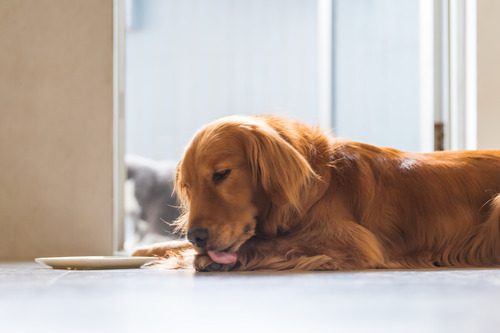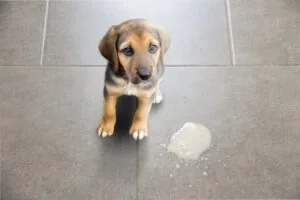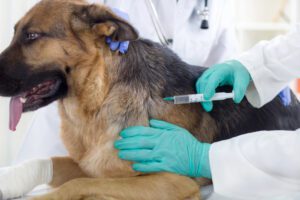Why Is My Dog Licking Their Paws?
You’re relaxing at home when you hear it: the rhythmic sound of your dog licking their paws again. It might seem like a harmless habit, but frequent paw licking can be a sign of something more than just a dirty foot or a passing itch. From allergies to anxiety, there are many reasons why dogs focus on their paws, and some of them can impact their health and comfort. If you’ve ever wondered what’s behind this behavior and when it’s time to take action, you’re in the right place. This blog takes a closer look at the causes of dog licking paws and what steps you can take to help your pet feel better.

Is It Normal for a Dog to Lick Their Paws?
It’s normal for dogs to groom themselves occasionally, especially after coming in from outside. Licking their paws can be a way to remove dirt, clean off irritants, or address a temporary itch. However, if you notice your dog licking their paws frequently, or focusing on one paw in particular, it may be a sign that something more is going on.
Frequent licking may lead to red, inflamed skin or even secondary infections. It’s important to monitor how often your dog engages in this behavior and whether it’s accompanied by other signs, such as limping, chewing, or a change in temperament. If the licking becomes persistent or obsessive, that’s a clear indication to reach out to your veterinarian.
Why Do Dogs Lick Their Paws?
There are many potential reasons why a dog might develop a habit of licking their paws. Some causes are environmental or seasonal, while others are medical or behavioral in nature.
Allergies
Dogs can develop allergies to environmental triggers like pollen, grass, mold, or dust mites, as well as certain foods. When these allergens affect your dog, the irritation often appears in the skin, particularly on the paws. Dogs may lick, chew, or bite their paws in an attempt to relieve the itchiness. Seasonal allergies tend to flare up during specific times of year, especially in spring and fall. If you notice a pattern, that may help your vet pinpoint the allergen and recommend appropriate testing or treatment.
Skin Irritations and Infections
Minor cuts, insect bites, or contact with irritating chemicals (like lawn treatments or salt in winter) can all lead to paw discomfort. Dogs may lick to soothe the area, but over time, this can worsen the issue. Yeast infections and bacterial infections are also common, particularly in moist areas like between the toes. These infections can develop after excessive licking or exposure to moisture. Signs of infection may include redness, odor, discharge, or swelling.
Parasites
Fleas, ticks, and mites can all cause significant itching and discomfort, which may lead to licking. Mites, in particular, can result in conditions like mange, which is highly uncomfortable for dogs and requires medical care. If your dog’s licking is accompanied by hair loss, scabbing, or general discomfort, parasites may be to blame. A thorough skin and coat check by your vet can help identify the cause.
Pain or Injury
An injured paw can drive a dog to lick persistently at the site of the discomfort. Splinters, thorns, abrasions, or even arthritis in a paw or leg joint can lead to licking behavior. Sometimes the pain isn’t obvious, especially in early stages. If your dog is favoring one leg, limping, or licking a single paw repeatedly, there may be a hidden injury worth investigating.
Behavioral Causes
In some cases, the issue is psychological. Dogs experiencing boredom, anxiety, or stress may lick their paws as a form of self-soothing. Over time, this behavior can become habitual, even in the absence of a physical problem. This type of repetitive behavior is sometimes seen in dogs with separation anxiety, especially if they’re left alone for long periods. It may also occur if your dog isn’t getting enough mental or physical stimulation throughout the day.
What to Look For When Your Dog Is Licking Their Paws
Knowing what to watch for can help you better understand whether your dog’s paw licking is harmless or needs attention. Here are some key signs to monitor:
- Frequency and Duration: Occasional licking isn’t usually a concern. However, if the licking happens multiple times a day or goes on for long periods, it’s time to take a closer look.
- Redness, Swelling, or Odor: Inflammation, discharge, or a foul smell are signs that an infection or skin condition may be developing. These should not be ignored, especially if they worsen over time.
- Focus on One Paw: When a dog targets just one paw, it often indicates a localized issue such as an injury, bite, or object stuck between the toes. A thorough visual inspection can sometimes uncover the cause.
- Signs of Anxiety or Stress: If your dog licks their paws when you leave the house or during stressful situations (like thunderstorms), emotional triggers may be at the root of the behavior. Other signs of anxiety include pacing, whining, or destructive behavior.
When to Contact Your Veterinarian About Paw Licking
Persistent paw licking isn’t something you need to figure out alone. If your dog’s licking has become frequent, intense, or is affecting their quality of life, it’s best to schedule an exam. Your veterinarian at Shallowford Animal Hospital can perform a thorough assessment and determine the likely cause. In many cases, diagnostics like skin scrapings, allergy testing, or blood work can uncover hidden issues.
Treatment recommendations may vary based on the cause and may involve prescription medications, lifestyle adjustments, or changes in your pet’s environment. Avoid attempting home remedies, as these may worsen the irritation or delay proper treatment. The sooner you bring your dog in for evaluation, the sooner they can get relief.
How Veterinarians Diagnose the Cause of Paw Licking
Getting to the root of paw licking involves a systematic approach. Your vet will start with a detailed history of your dog’s behavior, including when the licking started, whether it’s seasonal, and whether it worsens in certain environments.
Physical Exam and Skin Checks
A close inspection of the paws, skin, and coat may reveal signs of inflammation, parasites, or injury. Your vet may look between the toes, around the nail beds, and at the pads to locate the source of irritation.
Allergy Testing
If allergies are suspected, food trials or skin testing may be used to identify triggers. Seasonal allergies may be managed with environmental changes or prescribed treatments.
Lab Work and Cultures
For suspected infections, your vet may take swabs for bacterial or fungal culture. Blood tests may be used to rule out underlying systemic conditions. These tools help build a complete picture of what’s affecting your pet’s skin and paws.
Supporting Your Dog’s Comfort and Health
Paw licking in dogs may seem minor at first, but it can quickly turn into a chronic issue if left unaddressed. Identifying the cause and working with your veterinarian at Shallowford Animal Hospital can make all the difference. If your dog is licking their paws more often or seems uncomfortable, give our team in Lewisville, NC, a call at (336) 945-4412. You can also schedule an appointment online. With the right care, your dog can get back to focusing on what they do best: being happy, active, and itch-free!
Share This Post
Recent Posts
About Shallowford Animal Hospital
Shallowford Animal Hospital and The Pet Spa at Shallowford are dedicated to the exceptional, compassionate care your pet deserves. Pets hold a very special place in our families, and we treat yours like our own.



